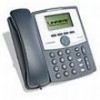Linksys SPA922 Cisco SPA9000 Voice System Web-UI Based Product Installation an - Page 115
Creating a Hunt Rule, Global Rule, Line-Specific Rule, Voice tab >, PBX Parameters, Hunt Groups
 |
UPC - 745883570836
View all Linksys SPA922 manuals
Add to My Manuals
Save this manual to your list of manuals |
Page 115 highlights
Configuring Special Features Managing Inbound Calls with Hunt Groups 6 • Resuming from a previous hunt with call forwarding to a receptionist Global Rule: 500:name="Scheduling",102,103,101,hunt=ne; 45;240,cfwd=100 Line-Specific Rule: 102,103,101,hunt=ne; 45;240,cfwd=100 An incoming call is routed in "next station" order (hunt=ne). When a new call is received, the system resumes the previous hunt. For example, suppose that station 103 answered the most recent call to the group. A new call is routed to the next station in the list, which is station 101. If the call is unanswered, then it cycles to station 102, and so on. Each phone rings for 45 seconds (45;). After a total of 240 seconds has elapsed, the call is forwarded to station 100 (240,cfwd=100). Creating a Hunt Rule Use the following procedure to create a global hunt rule or a line-specific hunt rule. STEP 1 Start Internet Explorer, and then enter the IP address of the SPA9000. Click Admin Login and then click Advanced. STEP 2 Proceed as needed, depending on the type of hunt rule: • Global Rule: Click Voice tab > SIP. Scroll down to the PBX Parameters section. Find the Hunt Groups field. • Line-Specific Rule: Click Voice tab > Line N, where N is the line interface number. Scroll down to the Subscriber Information section. Find the Contact List field. STEP 3 Type your hunt group rule. See "Syntax for Hunt Rules," on page110 and "Examples for Hunt Rules," on page111. STEP 4 Click Submit All Changes. The phones reboot. STEP 5 To verify the settings: • Global Rule: Place a call to the new hunt group by entering the extension number or by using the Corporate Directory to select the group name and dial the group. SPA9000 Voice System Installation and Configuration Guide for Web UI 113















